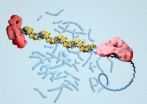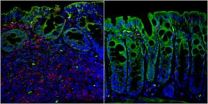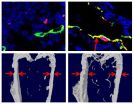(Press-News.org) PROVIDENCE, R.I. [Brown University] — Within our fat lives a variety of cells with the potential to become bone, cartilage, or more fat if properly prompted. This makes adipose tissue, in theory, a readily available reservoir for regenerative therapies such as bone healing if doctors can get enough of those cells and compel them to produce bone.
In a new study in the journal Stem Cell Research & Therapy, scientists at Brown University demonstrate a new method for extracting a wide variety of potential bone-producing cells from human fat. They developed a fluorescent tag that could find and identify cells expressing a gene called ALPL. Expression of the gene is an indicator of bone-making potential.
If the tag finds the RNA produced when the gene is expressed, it latches on and glows. A machine that detects the fluorescing light then separates out the ALPL-expressing cells.
In the paper, the scientists report that their method produced more than twice the yield of potential bone-makers (9 percent) compared to their best application of another method: sorting cells based on surface proteins presumed to indicate that a cell is a stem cell (4 percent).
Brown University has applied for a patent on the method of gene expression tagging for producing a tissue.
Meanwhile, the ALPL-expressing cells produced on average more than twice as much bone matrix (and as much as nine times more in some trials) during three weeks of subsequent cultivation than a similar-sized population of unsorted adipose tissue cells and almost four times more bone matrix than cells that don't express ALPL. ALPL-expressing cells were also better at making cartilage or fat.
A couple of other research groups have also sorted stem cells based on gene expression, but they have not done so specifically with the goal of enriching cell populations for a specific tissue, the researchers said.
Lead author and Brown graduate student Hetal Marble said targeting gene expression rather than surface proteins for the purpose of gathering cells to make a new tissue is a "paradigm shift" in the following regard: Gene expression provides a way to target any cell based on whether it can produce another tissue, while targeting surface proteins limits researchers to harvesting cells that fit a presumed definition of being a stem cell. The new approach, she said, is more pragmatic for the purpose.
"Approaches like this allow us to isolate all the cells that are capable of doing what we want, whether they fit the archetype of what a stem cell is or not," Marble said. "The paradigm shift is thinking about isolating populations that are able to achieve an end point rather than isolating populations that fit a strictly defined archetype."
In their experiments, though, the team tolerated a four-day delay that they'd like to dispense with in the future. It takes that long for the maximum number of cells to express ALPL when cells are chemically primed to do so.
In future research, said senior author Eric Darling, the Manning Assistant Professor of Molecular Pharmacology, Physiology and Biotechnology and a member of the Center for Biomedical Engineering assistant professor of medical science, the team would like to target a gene expressed much earlier in the differentiation process to see if they can avoid a priming period.
If they can apply the method based on a gene that's expressible within a matter of hours, that could allow future surgeons working on bone healing to take out some of a patient's fat cells, sort out the best bone-producers (primed or not) and then implant those cells in the bone break within the same surgical session.
"If you can take the patient into the OR, isolate a bunch of their cells, sort them and put them back in that's ideally where we'd like to go with this," Darling said. "Theoretically we could do this with other genes that might upregulate very quickly or are innately expressed.
INFORMATION:
In addition to Marble and Darling, other authors are Bryan Sutermaster, Manisha Kanthilal, and Vera Fonseca.
The National Science Foundation (CBET1253189), The National Institutes of Health (R01 AR063642, P20 GM104937) and the U.S. Department of Education (P200A120064) provided support for the study.
An innovative patient management system at the acute stroke unit of Kelowna (BC) General Hospital has reduced the number of stroke patient bed days by more than 25 per cent, according to a study of the system presented at the annual Canadian Stroke Congress in Vancouver.
In total, it is estimated the new system is saving the 380-bed hospital more than 1,000 bed days per year. This represents annual savings of up to $800,000, all achieved without the need for any new investment in devices, treatments or personnel.
"It's a win-win situation," says Dr. John B. Falconer, ...
At the first sign of a stroke, time is of the essence. For every minute of delay in treatment, people typically lose almost two million brain cells. Yet a new study presented at the Canadian Stroke Congress reveals that those delays – in getting the right tests and the right drugs – can be longer when people experience a stroke in a hospital.
Investigators from the University of Toronto Faculty of Medicine, the Institute for Clinical Evaluative Sciences (ICES) and the University Health Network looked at data from acute care facilities in Ontario over nine years. They ...
Researchers at the University of Texas Medical Branch at Galveston say that sexting may be the new "normal" part of adolescent sexual development and is not strictly limited to at-risk teens. The findings, published in the journal Pediatrics, are from the first study on the relationship between teenage sexting, or sending sexually explicit images to another electronically, and future sexual activity.
The study results indicate that sexting may precede sexual intercourse in some cases and further cements the idea that sexting behavior is a credible sign of teenage sexual ...
We might love to reminisce and tell others about our extraordinary experiences — that time we climbed Mt. Kilimanjaro, got to taste a rare wine, or ran into a celebrity on the street — but new research suggests that sharing these extraordinary experiences may come at a social cost. The findings are published in Psychological Science, a journal of the Association for Psychological Science.
"Extraordinary experiences are pleasurable in the moment but can leave us socially worse off in the long run," says psychological scientist and study author Gus Cooney of Harvard University. ...
Children's future writing difficulties can be identified before they even learn how to begin writing, according to a new study by Professor Phaedra Royle and Postdoctoral fellow Alexandra Marquis of the University of Montreal's School of Speech Language Pathology and Audiology. The researchers are interested in oral language skills and their impact on grammar and spelling learning. Their work shows that oral language is a good predictor of writing difficulties. "The more children are able to use verb tense in spoken language, the more easily they can learn written language," ...
Researchers from UCL, Stanford Engineering, Google, Chalmers and Mozilla Research have built a new system that protects Internet users' privacy whilst increasing the flexibility for web developers to build web applications that combine data from different web sites, dramatically improving the safety of surfing the web.
The system, 'Confinement with Origin Web Labels,' or COWL, works with Mozilla's Firefox and the open-source version of Google's Chrome web browsers and prevents malicious code in a web site from leaking sensitive information to unauthorised parties, whilst ...
Scientists have taken pictures of the BRCA2 protein for the first time, showing how it works to repair damaged DNA.
Mutations in the gene that encodes BRCA2 are well known for raising the risk of breast cancer and other cancers. Although the protein was known to be involved in DNA repair, its shape and mechanism have been unclear, making it impossible to target with therapies.
Researchers at Imperial College London and the Cancer Research UK London Research Institute purified the protein and used electron microscopy to reveal its structure and how it interacts with ...
An international collaboration of scientists has identified a fifth of the genetic factors that cause height to vary between individuals.
A study which examined data on DNA from more than 250,000 people, published on October 6 in Nature Genetics, roughly doubles the number of known genome regions involved in height to more than 400. It also revealed that more than half of the factors involved in determining height are explained by simple common genetic variation - the sort of genetic variation that exists in more than 1 in 10 people.
The collaboration, co led by the ...
Researchers at University of California, San Diego School of Medicine have discovered that T-cells – a type of white blood cell that learns to recognize and attack microbial pathogens – are activated by a pain receptor.
The study, reported online Oct. 5 in Nature Immunology, shows that the receptor helps regulate intestinal inflammation in mice and that its activity can be manipulated, offering a potential new target for treating certain autoimmune disorders, such as Crohn's disease and possibly multiple sclerosis.
"We have a new way to regulate T-cell activation ...
Experiments in mice with a bone disorder similar to that in women after menopause show that a scientifically overlooked group of cells are likely crucial to the process of bone loss caused by the disorder, according to Johns Hopkins researchers. Their discovery, they say, not only raises the research profile of the cells, called preosteoclasts, but also explains the success and activity of an experimental osteoporosis drug with promising results in phase III clinical trials.
A summary of their work will be published on Oct. 5 in the journal Nature Medicine.
"We didn't ...



